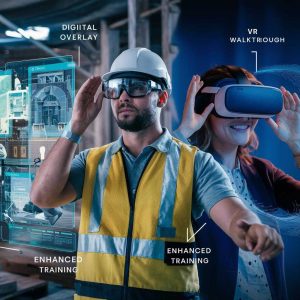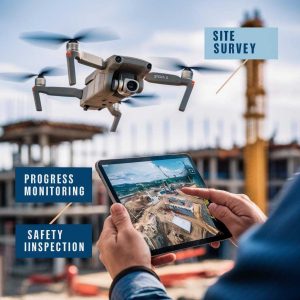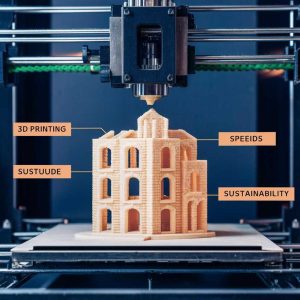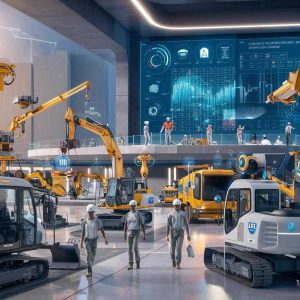Introduction
The construction industry is undergoing a transformative phase driven by integrating emerging technologies. These innovations improve productivity and reduce risk and open up the possibility of improved sustainability and likelihood at lower expense in the construction industry. This piece will, therefore, look at the current emerging technologies within construction works most likely to transform the sector.
1. Building Information Modeling
Undoubtedly, the application of Building Information Modeling is changing the face of the construction Industry. BIM refers to developing a model of a construction project’s physical and operational aspects. With this technology, stakeholders can coordinate their efforts regarding all the project elements from conception to construction and even to usage.
Benefits of BIM:

- Building Information Modeling
- Improved Collaboration: BIM allows different professionals to work in a shared model, that helps to avoid miscommunication and errors.
- Enhanced Visualization: Programmes in three dimensions enhance the Actuality of the job reduces disturbances in the undertaking that are most probable to be met.
- Cost and Time Efficiency: Naturally, since problem detection occurs in the early BIM stages, there are no costly iterations and shortened projects’ cycle time.
2. Augmented Reality and Virtual Reality
Almost every business area sees the utility of AR and VR in the construction industry as these increase efficiency through an enhanced immersive real environment experience toward planning, execution, and implementation of projects in the construction industry.
Applications of AR and VR:

- Design Visualization: The client can take a virtual tour of the building project before starting construction; adjustments can then be made.
- Training and Safety: Employees can practice in simulation, adhere to certain precautions, and control the equipment with no possibility to go wrong at least not in a hazardous way.
- On-site Assistance: Thus, the technology referred to as AR can place digital information on the physical site and assist the workers to adhere to the blueprints or expose errors.
3. Drones
The use of drones is revolutionizing the operation of construction sites. Drones offer a bird’ s-eye view of the site, which was previously hard to capture and costly.
Uses of Drones in Construction:

- Site Surveys: The news shows how drones easily and safely scan large areas, producing detailed maps and 3D models.
- Progress Monitoring: It can help document the progress of constructing by flying drones at certain intervals; this will assist in averting the construction schedule.
- Safety Inspections: These platforms can examine dangerous zones, thus sparing employees danger.
4. 3D Printing
In fact, the application of 3D printing in construction is gradually developing into a revolutionary tool that marks a new era for constructing large and complex structures quickly and at a considerably low cost.
Advantages of 3D Printing:

- Customization: One of the advantages of 3D printing you get parts that are specific to the requirements of a particular project only.
- Speed: This new technology makes it possible to build a building or a house in a shorter time than would have been required by normal methods.
- Sustainability: Therefore, nanoscale 3D printing reduces material wastage and helps to adopt recycle material to make construction more environmental friendly.
5. Robotics
Robots are being applied to various types of construction that increase accuracy and speed.
Roles of Robotics in Construction:

- Bricklaying Robots: These robots can even be used to lay bricks within the shortest time and to a much higher accuracy than a human being could provide and thus would save on the costs.
- Demolition Robots: Albeit operating through remote control, these robots are useful in demolition work as they do not endanger the life of the workers.
- Automated Machinery: Different construction teams employ the use of an automated bulldozer and excavator which tremendously enhance the construction site productivity.
6. Internet of Things (IoT)
Wireless devices in construction sites use IoT technology to connect the devices and equipment on-site and provide information that can enhance the construction business’s performance.
IoT Applications in Construction:

- Equipment Monitoring: They can track the functional capabilities and condition of machinery, and show different levels of maintenance needs.
- Site Management: It may also be useful to note the physical states in which the sites should provide their workers, environment temperature, relative humidity as well as air quality.
- Safety Enhancements: New technologies, such as wearable devices, may help track workers’ movements and conditions and give bosses signals regarding some risks.
7. Advanced Materials
Another branch of construction that is being advanced through technology is using a new generation of materials.
Examples of Advanced Materials:

-
Self-Healing Concrete: This particular type of concrete is capable of ‘curing’ its own cracks, and as a result, various structures remain sound for a longer period before they are called to undergo repairs.
-
Graphene: Life style engineers use graphene a strong and electrical conducting material to produce lightweight and durable infrastructural components.
-
Aerogels: Thanks to the fact that aerogels are almost completely open structured silicate networks which are, at the same time, very light they are ideal to be used to introduce additional insulation into buildings.8. Artificial Intelligence (AI)Technological developments have embraced the innovation of artificial intelligence in enhancing construction, enriching projection and strengthening the decision-making procedures within construction firms.
AI Applications in Construction:

- Predictive Analytics: The ability to analyze prior similar projects help AI to predict possible delay or cost overruns or any other issues likely to occur on the project to avoid or mitigate them where possible, this aspect alone reduces human error significantly.
- Design Optimization: The pro-active packages of artificial intelligence can generate more innovative structures that are more efficient and sustainable as well.
- Safety Monitoring: Use of AI cams and sensors for live monitoring of construction sites opens a possibility for streamlining workers’ safety hazards and prevention of accidents.
9. Modular Construction
Modular construction also referred to as prefabricated construction involve assembling parts of a structure in a factory then transporting them to the building site.
Benefits of Modular Construction:

- Speed: Another way to save time is based on the principles of modular construction, when the various parts of the building can be built at once.
- Quality Control: High quality is achieved, and there are fewer defects when construction occurs in controlled structures.
- Reduced Waste: This tends to cut down some of the wastage that is usually observed during construction since the processes used are more accurate.
Conclusion
What was observed in the process was that the application of the emerging technologies in construction is not only a myth but a reality in the future. These advancement made of emerging technologies in construction are still giving exquisite changes in various aspects including efficiency, safety, and sustainability aspects currently. It will be indispensable to apply such technologies in the future as construction industry evolves and construction works have to meet new challenges introduced by highly specialized construction projects.














